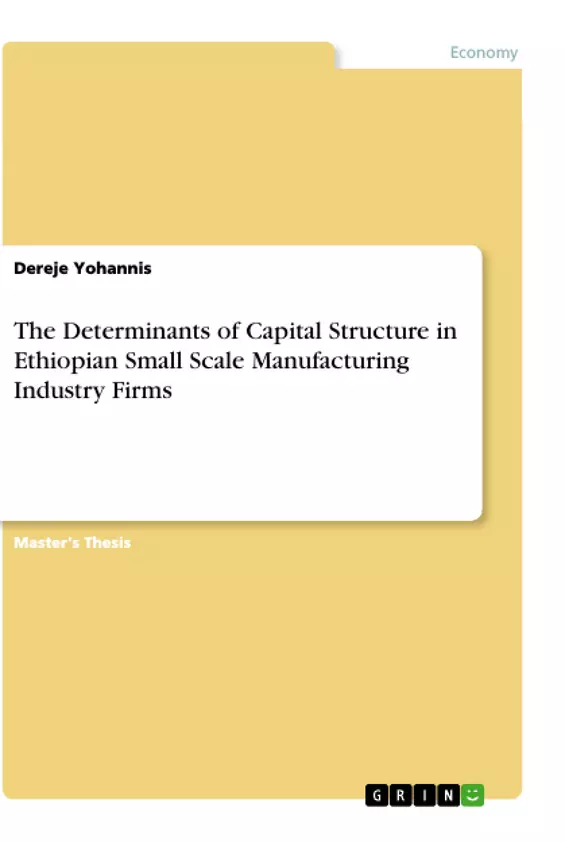The purpose of the study is investigating the determinants of capital structure for Small Scale Manufacturing Firms (SSMFs) in Ethiopia. Hypotheses utilizing trade-off, pecking order and agency theories are empirically examined using a series of firm characteristics: size, tangibility, profitability, earning volatility, age and macroeconomic variable (GDP growth rate, inflation rate and interest rate). A structured record review was made to collect a panel data, which include 20 SSMFs year observations of 11 years over the period 1998 – 2008 E.C.
The findings suggest that profitability, earning volatility, age, growth, GDP, inflation rate and interest rate variables are the most important determinants of capital structure of SSMFs in Ethiopia. The findings also reveal that the dominant capital structure theories (trade-off, pecking order, and agency theories) appear indeed to be valid for Ethiopian SSMFs’ capital structure; in fact, trade-off theory best explains Ethiopian SSMFs’ capital structure. All firm specific variables except Size, tangibility and growth variables seem to have an effect on the level of leverage in Ethiopian SSMFs.
Inhaltsverzeichnis (Table of Contents)
- CHAPTER ONE
- 1. INTRODUCTION
- 1.1. Background of the Study
- 1.2. Statement of Problem
- 1.3. Hypotheses
- 1.4. Objectives of the Study
- 1.4.1 General objective
- 1.4.2 Specific objective
- 1.6. Significance of the Study
- 1.7. Scope and Limitation of the Study
- CHAPTER TWO
- 2. LITERATURES REVIEW
- 2.1. Definition of Capital Structure and Small Scale Manufacturing Industries
- 2.2. Theories of Capital Structure
- 2.2.1. Trade-off Theory
- 2.2.2. Pecking Order Theory
- 2.2.3. Agency Theory
- 2.3. The Determinants of Capital Structure
- 2.3.1. Size
- 2.3.2. Tangibility
- 2.3.4. Earnings Volatility
- 2.3.5. Growth
- 2.3.6. Age
- 2.3.7. External Determinants of Capital Structure
- 2.4. Empirical literature Review of study
- 2.5. General result of the empirical study
- 2.6. Conceptual Framework
- CHAPTER THREE
- 3. RESEARCH METHODOLOGY
- 3.2. Research Approach
- 3.3. Sampling Design
- 3.4. Variables in the Study
- 3.4.1. Dependent Variable
- 3.4.2. Independent Variables
- 3.6. Data Analysis Technique
- 3.7. Model Specification Test
- 3.7. Classical Linear Regression Assumptions and tests
- CHAPTER FOUR
- 4. ANALYSIS RESULTS AND DISCUSSION
- 4.1 Descriptive analysis
- 4.3 Model Specification Test
- 4.3.1 Test of Data stationary or non-stationary
- 4.4 CLRM Assumptions and Diagnostic Tests
- 4.4.1 Normality Test
- 4.4.2 Multicollinearity Test
- 4.4.3 Correlation Analysis
- 4.4.4 Autocorrelation Test
- 4.4.5 Heteroscedasticity Test
- 4.5 Regression Analysis and Discussion of Results
- 4.5.1 Regression Analysis
- 4.5.2 Discussion of Results
- Chapter Five
- 5. Conclusions and Recommendations
- 5.1 Conclusions
- 5.2 Recommendations
Zielsetzung und Themenschwerpunkte (Objectives and Key Themes)
This thesis aims to explore the determinants of capital structure for Small Scale Manufacturing Firms (SSMFs) in Ethiopia. It seeks to understand how factors like size, profitability, and macroeconomic variables influence a firm's financing choices.
- Capital structure in Ethiopian SSMFs
- Theories of capital structure (trade-off, pecking order, and agency)
- Determinants of capital structure in Ethiopian SSMFs
- Empirical analysis of capital structure decisions
- The impact of macroeconomic variables on capital structure
Zusammenfassung der Kapitel (Chapter Summaries)
Chapter One introduces the study's background, problem statement, hypotheses, objectives, and significance. Chapter Two reviews relevant literature on capital structure theories and determinants, focusing on the trade-off, pecking order, and agency theories. It also presents an overview of empirical studies on capital structure in emerging markets. Chapter Three outlines the study's research methodology, including data collection techniques, variables, and analysis methods. Chapter Four presents the analysis results and discussion, covering descriptive statistics, model specification tests, and regression analysis.
Schlüsselwörter (Keywords)
The study's key terms encompass capital structure, small and medium enterprises (SMEs), Ethiopian manufacturing industry, financial leverage, trade-off theory, pecking order theory, agency theory, firm size, profitability, and macroeconomic variables.
- Quote paper
- Dereje Yohannis (Author), 2019, The Determinants of Capital Structure in Ethiopian Small Scale Manufacturing Industry Firms, Munich, GRIN Verlag, https://www.grin.com/document/508908



